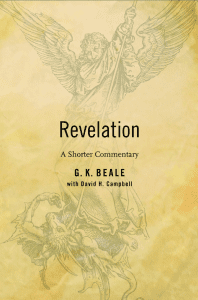 The Book of Revelation has perhaps the most radical vision of the Story of God in the whole Bible. But that Story counters the story told by Rome, which, as I wrote in our last post,
The Book of Revelation has perhaps the most radical vision of the Story of God in the whole Bible. But that Story counters the story told by Rome, which, as I wrote in our last post,
The fundamental idea then is that the gods gave the world Rome; they gave the world Rome as a blessing and those who are in line with Rome will experience the blessings of the gods. Rome was all mighty and any rebellion was death — Rome ties together imperial power and divine blessing. To question Rome was to question God.
So what is John’s Story? David DeSilva, in Unholy Allegiances: Heeding Revelation’s Warning, sketches that Story and it is the Story the Christian is to tell and indwell. The Story is discovered by revelation and we learn the Story when the skies crack open to see what is really going on in the cosmos, and what is going on all begins in the Throne Room of God, and we glimpse the center of this Story in Revelation 4 and 5.
At once I was in the Spirit, and there before me was a throne in heaven with someone sitting on it. 3 And the one who sat there had the appearance of jasper and ruby. A rainbow that shone like an emerald encircled the throne. … 9 Whenever the living creatures give glory, honor and thanks to him who sits on the throne and who lives for ever and ever, 10 the twenty-four elders fall down before him who sits on the throne and worship him who lives for ever and ever. They lay their crowns before the throne and say…
5:1 Then I saw in the right hand of him who sat on the throne a scroll with writing on both sides and sealed with seven seals. 2 And I saw a mighty angel proclaiming in a loud voice, “Who is worthy to break the seals and open the scroll?” 3 But no one in heaven or on earth or under the earth could open the scroll or even look inside it. 4 I wept and wept because no one was found who was worthy to open the scroll or look inside. 5 Then one of the elders said to me, “Do not weep! See, the Lion of the tribe of Judah, the Root of David, has triumphed. He is able to open the scroll and its seven seals.” 6 Then I saw a Lamb, looking as if it had been slain, standing at the center of the throne, encircled by the four living creatures and the elders. The Lamb had seven horns and seven eyes, which are the seven spirits of God sent out into all the earth. 7 He went and took the scroll from the right hand of him who sat on the throne. 8 And when he had taken it, the four living creatures and the twenty-four elders fell down before the Lamb. Each one had a harp and they were holding golden bowls full of incense, which are the prayers of God’s people. 9 And they sang a new song, saying…
This is a cosmic vision, or a Story of the cosmos, and the Story begins with God on the Throne and the Lamb on the Throne, so the Story of John counters the Roman story because the emperor is thrown from the throne and God is enthroned and the Lamb is enthroned. Not the might of sword but the victory of the Lamb is the Story the church tells the Roman world. DeSilva sketches how this Throne Room Story begins to assume control of the cosmos for the sake of the People of God (too much to sketch here). This requires a battle against those who want allegiance that transcends allegiance to God and the Lamb.
The emperors, the city of Rome, all of it gets a new storied context of rebellion against the one true God. Babylon is all that needs to be said: the four beasts of Daniel 7 are meshed in John’s Story to form a monstrous beast and the result is Babylon the whore. Babylon becomes in John’s Story a wasteland.
Revelation, then, is a most practical book that teaches us to begin at the Throne Room where God rules and where the Lamb rules and, then, looking out onto the world to see the whole cosmos in light of that Throne Room. That is, the whole cosmos is judged by whether or not it worships the God of the Throne Room in the image of the Lamb who suffers and brings victory through the cross and resurrection.
John asks us to ask: “How do our country’s economic practices, political entanglements, and ideologies look when measured up against the Israelite prophets, Jesus’ teachings and example, and John’s critique of his own imperial context?” (71).











